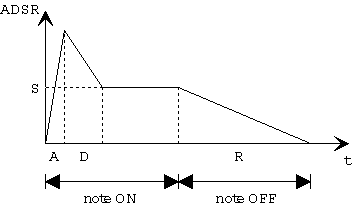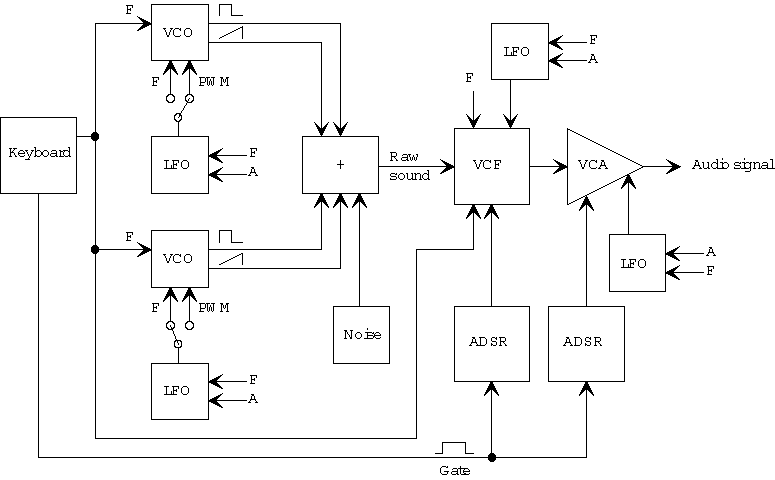The first synthesizers were analog, and mostly based on the principles of Robert MOOG and Donald BUCHLA, which were stated in the 60's and applied until the early 80's with of course some major improvements. Then came the digital synthesizers, opening a way for an infinite variety of sound synthesis and sampling. Also the effects which were analog became more powerful at the age of digital signal processing. The second major event after the digital synthesis was the birth of the MIDI standard, because it became possible for synthesizers to communicate with computers.
Within 10 to 15 years, digital synthesizers evolved very quickly. The
quality of the sounds they produced at the beginning was rather poor compared
to the analog ones, which could benefit from 30 years of technical improvement.
But they can now produce, besides the typical digital sounds, almost the
same sounds as the old synths' ones because they can use the same synthesis
techniques by digital simulation of analog electronic circuits. For this
reason, I think it can be useful to describe these principles here. I will
then go on with the other aspects of electronic music as suggested above.
The easiest way to synthesize a musical sound is to start from a signal with a lot of harmonics and to filter more or less of these harmonics to get the sound we desire. This method, known as the substractive synthesis, was of course used in the first modular synthesizers.
As a sound is mainly a question of amplitude variations, frequency variations
and timbre variations applied on a periodic signal, the model of modular
synthesizer invented by Robert MOOG consists of using variable frequency
oscillators, variable amplifiers and variable filters that can be controlled
by voltages. This general structure can be symbolized as follows :

A synthesizer is of course much more complex than this, but this general diagram is appropriate for a first approach.
The keyboard generates a key-dependant voltage which is sent to a Voltage-Controlled Oscillator. This VCO generates a simple signal (square-wave, sine-wave, triangle or saw-tooth) at a frequency proportional to the keyboard voltage. This gives the main tone of the sound to be generated.
Then the signal is sent to a Voltage-Controlled Filter, which modulates the ratio of harmonics in the signal (timbre). It is often a Low-Pass filter. If its cutoff frequency is set to the minimum, only the first few harmonics pass (or even only the fundamental), and the sound is very pure, very soft. If set to the maximum, everything passes through the filter and the sound is much more "aggressive".
The signal is finally sent to a Voltage-Controlled Amplifier, which gives to the note its dynamic properties. The sound should not appear and disappear immediately. This amplifier is therefore controlled in such a way that the sound appears with a certain velocity and disappears with another velocity. This is what we call the "enveloppe" of the sound. An enveloppe can be reduced to 4 major intervals : Attack, Decay, Sustain, Release.

The attack is the time chosen for the sound to reach its maximum level
starting from 0.
The decay is the time chosen for the sound to decrease from its maximum
level to the sustain level.
The sustain is the level where the sound will tend to go in the decay,
and the nominal level when holding a key indefinitely.
The release is the time chosen for the sound to decrease from the current
level to 0.
The ADSR is associated to a binary signal equal to 1 during ADS (note
ON) and 0 during R and more (note OFF ). This binary signal is called the
"Gate".
An ADSR can also be sent to the VCF to change the timbre in time. This
produces very interesting effects.
Moreover, some low-frequency oscillators (LFO) may be used to modulate
the VCO, the VCF or/and the VCA, in order to generate more complex sounds.
The basic modules of the MOOG structure can be multiplied to enhance the
sound synthesis : several VCO slightly shifted in their output frequencies,
added before being sent to the VCF, or another VCF in parallel with the
first one and being a band-pass instead of a low-pass... The possibilities
of this structure are almost infinite.
A few other points :
A VCO may have a PWM input (Pulse Wave Modulation). This allows to modulate the duty-cycle of the square-wave output. This produces a very interesting sound when modulated by a LFO. This sound has a lot of phasing, like when using two VCO with slightly shifted frequencies.
All the control voltages must correspond to exponential variations, because the human perception of the sound is logarithmic in frequency (by octave) and in intensity (decibels). For instance, the VCO must generate an exponential frequency so that the input voltage will follow a variation rule of 1V / Octave. For the intensity, the variation rule applied to the VCA could be something like 12 dB / V.
Some special modules may be added to enlarge the possibilities of the
instrument. A noise generator can improve wind instruments generation,
and allows some special effects. An effect generator transforms considerably
the sound of an analog synthe : Chorus, flanger and delay are particularly
efficient.
Now that the main principles have been explained, here is an example of diagram for an analog synthesizer :

The keyboard delivers a voltage to control the frequency of the signals
generated by the VCOs, and the shift of the VCF cutoff frequency to get
the same filtering effect whatever the tone is. It also delivers the gate
signal to control the ADSRs.
The square and saw-tooth signals from the VCOs outputs are sent to
a mixer where they are individually added.
The two VCOs are slightly shifted in frequency to produce a phasing
effect. This frequency shift can be variable in time by means of a LFO
connected to the frequency modulation input of a VCO. Another way of producing
a phasing effect (or a way to add more phasing when the previous method
is already used) consists of connecting a LFO to a PWM input.
In addition to the complex resulting waveform, a white noise can be
added (also individually), and we get the raw sound that has now to be
filtered and shaped in amplitude.
The sound filtering is performed by the VCF which is manually set to
a gliding cutoff frequency proportional to the fundamental. Nevertheless,
this cutoff frequency can be modulated by a LFO or/and an ADSR in frequency.
This allows a dynamic change of the timbre.
The sound is finally sent to a VCA controlled by an ADSR and a LFO
(useful to make an amplitude modulation - AM).
Such a synthesizer is able to produce a wide variety of sounds, but
these sounds will be highly improved if you add an effect module, providing
at least a chorus and a delay.
One method to achieve polyphony consists of generating the 12 highest notes of the keyboard with square-wave generators and to divide these signals successively to get the lower octaves. But this method is known to give a poor sound quality.
The best method relies on the use of a complete sound generator for each of the polyphony channels. When a key is pressed, the first generator is assigned to the corresponding note generation. When a second key is pressed while keeping the fist one, the second generator is assigned to the corresponding note generation and the two signals are mixed. And so on until the last available generator. Six sound generators are sufficient.
If the control buttons and potentiometers are multiplied by the number of channels, this leads to an expensive and complex synthesizer, but with the major advantage of being multitimbral : different sounds can be programmed by groups of channels and these groups can be assigned to a different part of the splitted keyboard.
But the control buttons and potentiometers can also control the whole
generators. In this case, their sounds are identical. The polyphonic synthesizer
is simpler to manufacture, so it is cheaper. It is also easier to use as
you don't have to perform the same tunings on all the modules to get a
maximum polyphony.
That's all I can tell you at the moment. If you want this tutorial to
continue, let me know !
![]()